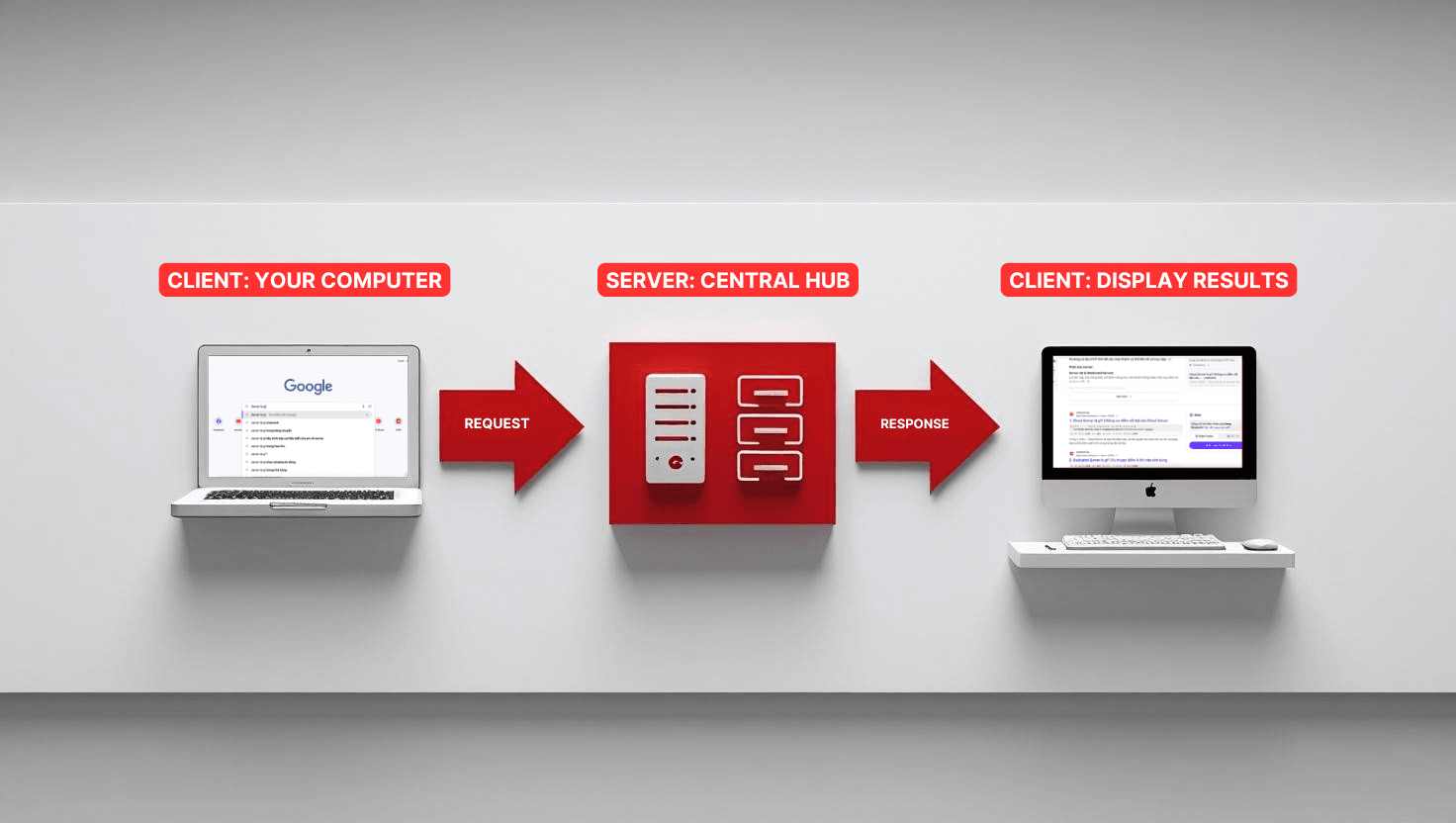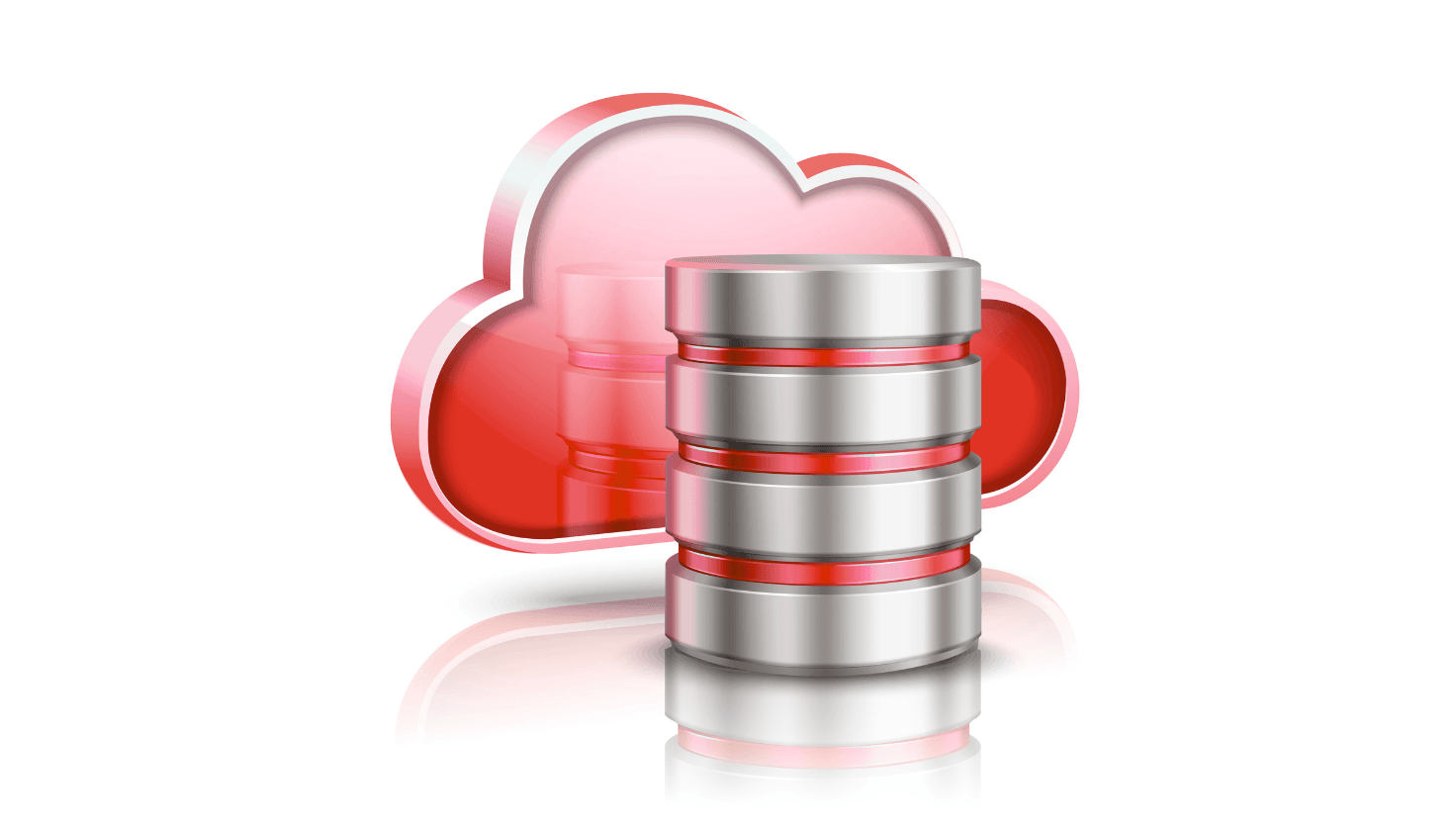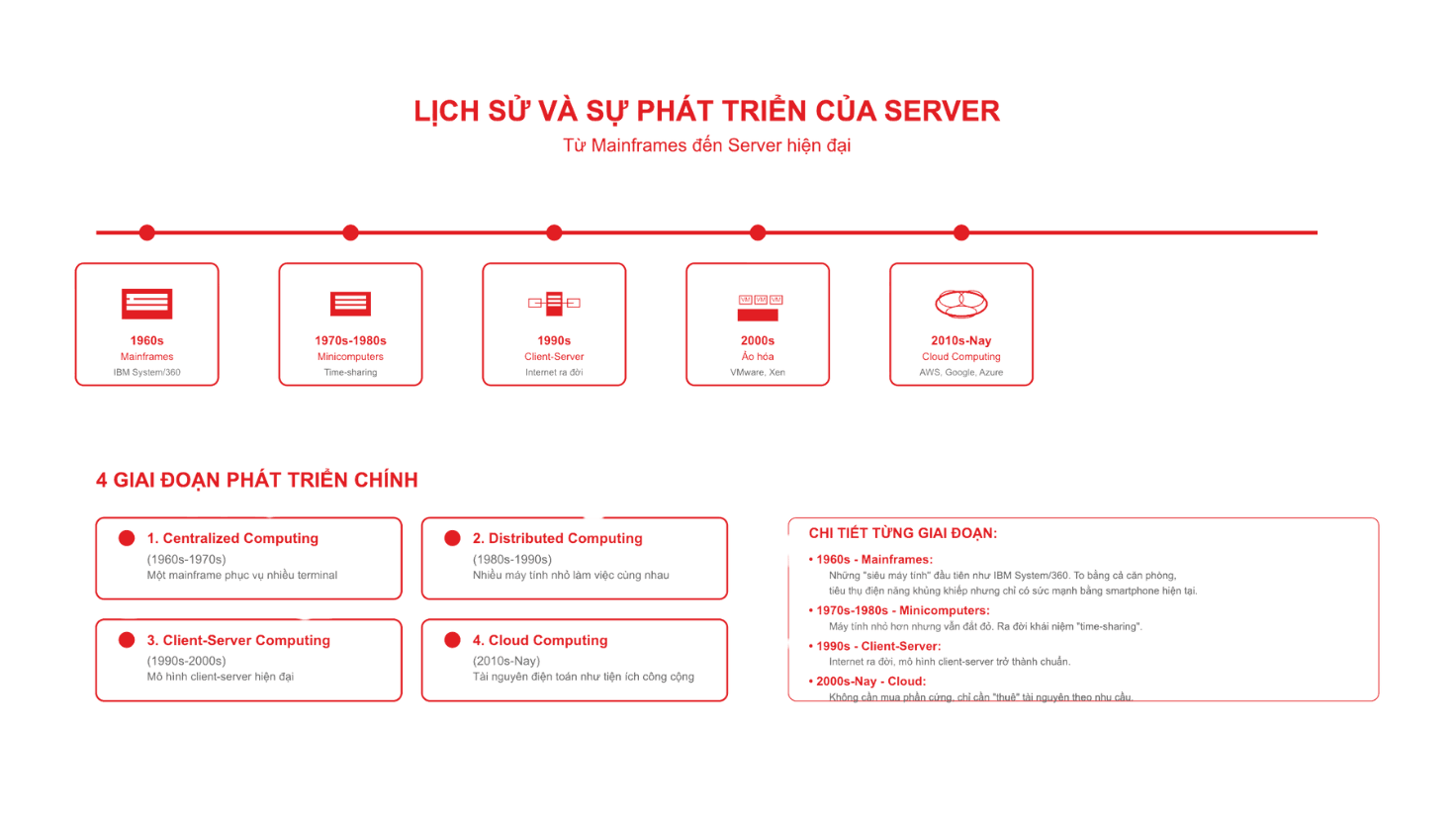What is a server?
A server is a computer system connected to the Internet or an internal network, responsible for providing services, resources, and data to other computers (called clients).
Simply put, a server is like a "waiter" in a restaurant. When you (client) order food, the waiter (server) receives the request, processes it, and brings the food to you. Similarly, when you access a website, your computer sends a request to the server, the server processes it and returns the website content for you to view.
The role of servers in IT systems
Servers play the role of operational centers for all modern digital systems:
Data storage: All information from images, videos, text to databases are safely stored on servers
Request processing: Receiving and processing millions of user requests every day
Service provision: Email, websites, mobile applications all operate thanks to servers
Access management: Controlling who can access which data
Easy-to-understand examples of servers
Website: When you type "google.com", Google's server receives the request and displays the homepage for you
Email: Gmail uses servers to store and send your emails to recipients
Online games: When playing PUBG Mobile, game servers process all player actions and synchronize with other gamers
Cloud storage: Google Drive, Dropbox use servers to store your files in the "cloud"
How servers process user requests in 3 steps
Servers operate based on the Client-Server model - the main foundation of all modern network systems. Below is a step-by-step guide to help you understand clearly how servers respond when you access a website or use online applications.

Step 1: Send request from client (user's machine)
When you access a website (for example: typing "facebook.com" in your browser), your computer or phone - called the client - will send a request to the server through the Internet.
Step 2: Server receives and processes the request
Immediately after receiving the request, the server will check the information, authenticate the user if necessary, then retrieve appropriate data from the storage system (for example: posts, images, messages...).
Step 3: Server responds and returns results to client
After processing, the server will send a response back to your device - including the website content or data you requested. This entire process usually takes place in just a few milliseconds.
Real example: When you access Facebook
Request: You type "facebook.com" in your browser Processing: Facebook server receives the request, checks login, searches for your newsfeed Response: Server sends back Facebook page with the latest posts
Important concepts
Traffic: The number of requests a server processes in a time period
Uptime: The time a server operates continuously without interruption (calculated as %)
IP Address: The unique address of a server on the Internet (example: 192.168.1.1)
DNS: System that converts domain names (facebook.com) to IP addresses
Server components and structure
A server is basically a computer, but designed with more powerful and durable components to operate 24/7.
Motherboard
The motherboard is the "backbone" of the server, connecting all components together. Unlike regular computers, server motherboards are designed to:
- Support multiple CPUs simultaneously
- Contain more RAM slots (usually 8-16 slots)
- Have more network ports and expansion slots
CPU - the brain of the server
Server CPUs are much more powerful than regular CPUs:
Multiple processing cores: From 8-64 cores (regular CPUs only have 4-8 cores) Multi-threading processing: Can process hundreds of tasks simultaneously Server optimized: Intel Xeon, AMD EPYC designed specifically for servers
RAM - temporary memory
Servers need extremely large RAM to process many simultaneous requests:
Capacity: From 32GB to 1TB RAM RAM type: ECC RAM with self-error correction capability High speed: Ensures fast data access
Storage - HDD/SSD/NVMe
Server storage prioritizes durability and speed:
Enterprise HDD: Durable, large capacity, cheap SSD: 10-100 times faster than HDD NVMe: Latest technology, super fast speed RAID: Combining multiple hard drives to increase performance and security
Other components
Power supply (PSU): Usually dual power supplies to ensure the server never loses power Network card: High-speed connections (1Gbps - 100Gbps) to handle large traffic Cooling system: Powerful fans and cooling because servers run 24/7
Common types of servers today
Depending on needs and budget, you can choose different types of servers. Each type has its own advantages and disadvantages.
Physical server (Dedicated server)
Dedicated Server is a physical server completely dedicated to one customer.
Advantages:
- Highest performance
- Full control
- Maximum security
- No shared resources
Disadvantages:
- Highest cost
- Requires technical knowledge
- Difficult to scale quickly
Suitable for: Large enterprises, websites with high traffic
Cloud server

Cloud Server is built on cloud computing platform, combined from multiple physical servers.
Advantages:
- Flexible scaling
- Pay-as-you-use
- High reliability
- Easy management
Disadvantages:
- Performance may be unstable
- Dependent on provider
- Long-term costs may be high
Suitable for: Startups, small and medium enterprises, scalable projects
VPS (Virtual Private Server)
VPS is a virtual server created by dividing a physical server into multiple parts.
Advantages:
- Balance price and performance
- Full root access
- Separate resources
- Easy to upgrade
Disadvantages:
- Shares hardware with other VPS
- Performance depends on "neighbors"
Suitable for: Small and medium websites, developers, personal projects
Shared hosting
Shared Hosting is multiple websites sharing resources of one server.
Advantages:
- Cheapest price
- Easy to use
- Provider manages everything
Disadvantages:
- Low performance
- Limited customization
- Poor security
Suitable for: Personal websites, blogs, small businesses
Quick comparison of server types
| Criteria | Shared Hosting | VPS | Cloud Server | Dedicated Server |
| Price | Cheapest | Medium | Flexible | Most expensive |
| Performance | Low | Medium | High | Highest |
| Security | Basic | Good | Very good | Excellent |
| Scaling | Difficult | Easy | Very easy | Difficult |
| Management | Automatic | Self-managed | Flexible | Self-managed |
What are servers used for? Real-world applications
Servers are present in almost all our digital activities. Below are the most common applications.
Enterprise data storage and processing
Internal information management:
- Store documents, contracts, reports
- Manage employee and customer information
- Automatic daily data backup
- File sharing between departments
Data analysis:
- Process Big Data for business decisions
- Create revenue and sales reports
- Analyze customer behavior
Website and application operation
Company website:
- Display business information
- Online sales (e-commerce)
- Customer interaction
- SEO and digital marketing
Mobile applications:
- Backend for iOS/Android apps
- Data synchronization between devices
- Payment and order processing
- Push notifications
Create dev/test environments
Software development:
- Code and test application environments
- Automated CI/CD pipeline
- Version control (Git)
- Staging environment
Testing:
- Performance and security testing
- Load testing with high traffic
- A/B testing new features
Email and internal data management
Email server:
- Business email (@companyname.com)
- High email security
- Unlimited email storage
- CRM integration
File server:
- Company's shared file storage
- Access permissions by group
- Automatic file sync
- Multi-tier backup
History and development of servers

From mainframes to modern servers
1960s - Mainframes: The first "supercomputers" like IBM System/360 were born. They were as big as a room, consumed enormous power but only had the power of a current smartphone.
1970s-1980s - Minicomputers: Smaller computers but still expensive. This period saw the birth of "time-sharing" concept - multiple users sharing one computer.
1990s - Client-Server: The Internet was born, the client-server model became standard. Specialized servers for web, email, database were developed.
2000s - Virtualization: Virtualization technology allowed running multiple virtual servers on one physical machine. VMware, Xen led this revolution.
2010s to present - Cloud Computing: Amazon AWS, Google Cloud, Microsoft Azure completely changed how we use servers. No need to buy hardware, just "rent" resources as needed.
4 main development stages
Centralized Computing (1960s-1970s): One mainframe serving multiple terminals Distributed Computing (1980s-1990s): Many small computers working together Client-Server Computing (1990s-2000s): Modern client-server model Cloud Computing (2010s-present): Computing resources as public utilities
Physical server vs Cloud server - Which to choose?
This is a question that most businesses face when deploying IT systems.
Detailed comparison
Cost:
- Physical server: High initial cost (50-200 million VND), but no monthly costs
- Cloud server: Low initial cost, but continuous monthly costs
Security:
- Physical server: Complete control, high physical security
- Cloud server: Dependent on provider, but has large security investments
Scalability:
- Physical server: Difficult to scale, need to buy additional hardware
- Cloud server: Scale instantly with just a few clicks
Performance:
- Physical server: Stable performance, no shared resources
- Cloud server: Performance may fluctuate, but improving
Situation suggestions
Choose Physical server when:
- Large enterprise with high investment budget
- Need maximum security (banks, government)
- Stable, predictable traffic
- Have professional IT team
Choose Cloud server when:
- Startup or small and medium enterprise
- Uneven traffic, may increase suddenly
- Need quick deployment
- Want to focus on business instead of IT management
Advice: Many businesses currently use Hybrid Cloud - combining both physical servers for important data and cloud servers for applications and websites.
Why do businesses need to use servers?
In the digital age, servers are not just "good choices" but have become "mandatory" for any business wanting to develop.
Centralized data management
Safe storage:
- All data stored in one safe place
- Automatic daily backup
- Data recovery when incidents occur
- Access permissions by position
Easy access:
- Employees access data from anywhere
- Quick information search
- File sharing between departments
- Real-time data synchronization
Reduce operating costs
Reduce hardware costs:
- No need to buy high-configuration computers for each employee
- Maximize server resource utilization
- Reduce maintenance and upgrade costs
Save energy:
- One powerful server replaces many weak computers
- Modern energy-saving technology
- Optimize operations by time
Enhanced security
Multi-layer security:
- Professional firewall
- Data encryption
- Two-factor authentication (2FA)
- 24/7 monitoring
Access control:
- Detailed permissions for each employee
- Log all access activities
- Automatically lock suspicious accounts
Easy system expansion
Scale according to needs:
- Add resources when company grows
- Reduce resources when not needed
- No worry about "running out of" storage
Easy integration:
- Connect with other systems
- Open API for developing new features
- Automate workflows
Things to know before renting/buying servers
Choosing the right server is an important decision that affects your business operations.
Features to consider
CPU:
- Number of cores
- Clock speed (GHz)
- CPU type (Intel Xeon, AMD EPYC)
RAM:
- Capacity (32GB, 64GB, 128GB...)
- RAM type (DDR4, DDR5)
- ECC or non-ECC
Storage:
- Hard drive type (HDD, SSD, NVMe)
- Capacity (1TB, 2TB, 10TB...)
- RAID configuration
Uptime:
- Provider's SLA (Service Level Agreement)
- Usually require 99.9% or higher
- Compensation when downtime occurs
Questions to ask yourself
Purpose of use:
- Website, email or database?
- Number of concurrent users?
- Which applications will run on server?
Budget:
- One-time or monthly cost?
- Budget for expansion?
- Calculate ROI (Return on Investment)
Growth level:
- Expected growth in the next 1-2 years?
- Plans for geographical expansion?
- Will new products/services affect?
Reputable rental suggestions
When choosing a server provider, prioritize companies that have:
- Long experience in hosting industry
- International standard data center (Tier 3, Tier 4)
- 24/7 support in Vietnamese
- High uptime SLA commitment
- Complete backup and disaster recovery
Frequently asked questions (FAQ)
Is a server a computer?
Yes, a server is essentially a computer but designed specifically to handle requests from multiple clients simultaneously. Servers have stronger configurations, higher durability and are optimized to run 24/7.
Is using cloud servers safe?
Cloud servers can be very safe if you choose reputable providers with multi-layer security features like firewall, encryption, monitoring. Sometimes cloud servers are even safer than self-managed servers because of professional security investments.
Can I build a server at home?
Absolutely possible, but only suitable for learning or testing purposes. For production environments, it's not recommended to build yourself because of lack of professional infrastructure like UPS, cooling, security, backup.
Do servers need regular maintenance?
Yes, servers need regular maintenance including software updates, security patches, resource monitoring, hardware cleaning. If you rent managed servers, the provider will handle this.
What is the average server rental price?
Server rental prices vary greatly depending on configuration and server type:
- Shared Hosting: 50,000 - 200,000 VND/month
- VPS: 200,000 - 2,000,000 VND/month
- Cloud Server: 500,000 - 10,000,000 VND/month
- Dedicated Server: 5,000,000 - 50,000,000 VND/month
Conclusion
Servers are the central processing brain for all modern digital systems. From the smallest website to the most complex application, nothing can operate without servers.
Understanding servers clearly helps you make the right decisions for your business, optimize costs and improve operational efficiency. Whether you choose physical servers, cloud servers or VPS, the most important thing is that it must fit your needs and budget.
If you are considering using servers, please consult optimal server solutions at VNETWORK immediately. With over 15 years of experience, VNETWORK's expert team will advise the most suitable solution for your business.
.jpg)